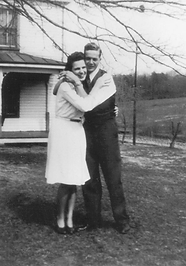
THE BOYS







MORE HISTORY
Green's Drugstore

Green's Drugstore in Bedford, Virginia, holds deep historical significance as the town’s central gathering place and the location where the tragic news of D-Day first reached the community.
Before World War II, it was a popular spot for locals—including the "Bedford Boys"—to socialize, grab a soda, and catch up on news. But on July 17, 1944, it became the site of profound loss when Elizabeth Teass, the teletype operator, received telegrams announcing the deaths of 19 of the 35 Bedford soldiers killed during the D-Day invasion. The devastating news gave Bedford the highest per capita loss of any U.S. town on that day, turning the drugstore into a place of collective mourning.
Today, the building houses the Bedford Boys Tribute Center, a museum dedicated to preserving the stories, artifacts, and legacy of these young men. It stands not only as a place of remembrance and education but as a testament to the enduring impact of their sacrifice on this close-knit community.

The tragic losses of the Bedford boys on D-Day brought national attention to the devastating impact of war on a single community. This profound sacrifice highlighted the human cost of war and underscored the tragedy of so many deaths coming from one hometown.
At the time, units were often formed from local National Guard groups, naturally concentrating men from the same communities. The Bedford boys’ story raised awareness within the military about the dangers of such concentration. Over time, the military moved away from forming units based solely on geography.

"Blue and Gray" Division
If you’ve seen the movie, "Saving Private Ryan", you may recognize the insignias worn by the soldiers—many of them belonged to the 29th Infantry Division. Nicknamed the “Blue and Gray,” the division's motto is "Twenty-Nine, Let’s Go!" The nickname reflects its roots: the unit was originally formed with National Guard soldiers from Pennsylvania, Delaware, Maryland, Virginia, and Washington, D.C.

The unit patch features two interlocking teardrops, a design inspired by the Korean taegeuk symbol, which represents unity and balance. This emblem was intentionally chosen to honor the division’s unique composition—bringing together descendants of soldiers who fought on opposite sides of the Civil War. The goal was to promote unity and morale, and by all accounts, it worked.

Formed in 1917 as part of the National Guard, the 29th Infantry Division was quickly deployed to France during World War I, landing in Brest on June 8, 1918. As part of the American Expeditionary Force, the division captured over 2,000 enemy soldiers, though it suffered a 30% casualty rate.
After returning to the U.S. in May 1919, the division was reorganized but remained an active National Guard unit. With the outbreak of World War II, the 29th was federally reactivated in 1941 and began training for overseas deployment. What followed was a legacy etched into history—most famously on the beaches of Normandy.
MORE RESOURCES

Dawn on Omaha Beach
Elisha Ray Nance

